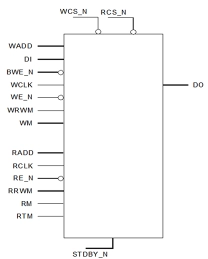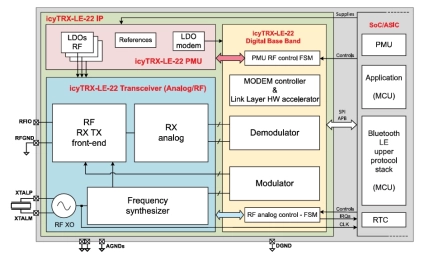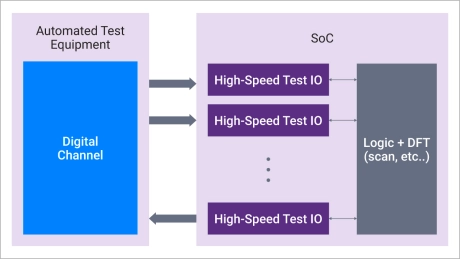BIST IP
Filter
Compare
867
IP
from
51
vendors
(1
-
10)
-
eFlash BIST IP
- The BIST can realize all eFlash testing items, covering UMC’s 40nm and 55nm processes, as well as SST’s 0.11um and 0.18um processes, and customized embedded eFlash IP wafer software testing and final testing.
- The BIST features a flexible serial interface, reducing the need for IC test pins and increasing testing flexibility.
-
Dual Port Register File Compiler (1 Read-only port, 1 Write-only port) - GF 22FDX+
- Uses 8T-TP185SL bit cells.
- Isolated Supplies: Periphery and array power domains can be independently powered down in standby mode.
- Deep Sleep Standby Mode: Memory retains data at minimal power via internal biasing.

-
HBM4 PHY IP
- Supports JEDEC HBM4 DRAMs
- Supports data rates up to 12 Gbps
- Supports up to 32 independent 64-bit memory channels
- Pseudo-channel operation supported to enable up to 64 32-bit pseudo-channels with 2048-bit PHY
-
USB Super-speed+ PHY
- Fully compliant with USB 3.2 Gen2 specification.
- Supports data rates of 5Gbps (Gen1), 10Gbps (Gen2), and 20Gbps (Gen2x2).
- Compatible with PIPE interface:
- 8/16/32-bit at original PIPE.
-
SLVS-EC RX PHY IP
- Fully compliant with SLVS-EC v3.0 specification.
- Supports both synchronous and asynchronous clocking.
- Up to 10Gbps per lane with 40-bit parallel data bus.
- Maximum output clock frequency of 250MHz.
-
Bluetooth® Low Energy 6.2 PHY IP with Channel Sounding
- The icyTRX-LE-22 RF transceiver PHY IP delivers an optimal trade-off between power consumption and Bluetooth Low Energy (LE) RF performance — excellent sensitivity and strong interference rejection — while minimizing the overall cost for loT applications.
- Occupying just 0.57 mm2 in a 22 nm technology (7 metal layers), the analog RF portion of the IP integrates on-chip passives and Built-In-Self-Test (BIST) structures to drive down silicon area, wafer cost, bill of materials, and production-test expenses.

-
TSMC N3P 1.2V High-Speed Test IO
- The AI and HPC industries are advancing toward chiplet-based designs to achieve superior performance, as traditional monolithic SoCs face scaling challenges
- Heterogeneous integration is driving semiconductor innovation but adds complexity to chip design, requiring advanced testing methodologies and improved Automated Test Equipment (ATE)
- Increasing test patterns and limited package pins demand high-bandwidth IOs, while advancements in ATE capabilities further necessitate optimized GPIOs to support higher-speed, efficient and low-cost testing
- Synopsys High-Speed Test IO IP is a cutting-edge IO interface solution that enables efficient, high-speed testing of complex semiconductor designs while minimizing hardware complexity and cost

-
GDDR6 PHY IP on GF 12nm LPP
- The UniIC GDDR6 PHY,subsequently referred to as the UNIIC_GD6PHY, is designed for performance and power efficiency, its target is to deliver industry-leading data rates of up to 12Gbps/13Gbps/14Gbps and is compatible with JEDEC standard JEDEC250 and DFI 3.1
- The UNIIC_GD6PHY is used to transfer the Command/Address and Datas between the memory controller and the GDDR6 DRAM device; _x000D_ The UNIIC_GD6PHY is available in Global Foundries FinFET 12LPP technology
- The UNIIC_GD6PHY is fully documented and comes with a comprehensive set of deliverables for ease of system modeling and integration.
-
DDR4/LPDDR4 PHY Interface
- The DDR PHY IP is a combination of hard macro, I/O Pad and synthesizable RTL to provide a physical interface to JEDEC standard DDR3/DDR4 SDRAM memories.
- The synthesizable RTL (ddr_phy_top) provides control functions such as initialization, SDRAM interface training, impedance calibration and programmable configuration controls.